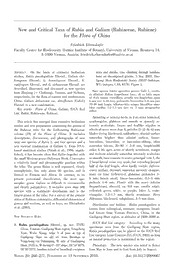
New and Critical Taxa of Rubia and Galium (Rubiaceae, Rubieae) for the Flora of China PDF
Preview New and Critical Taxa of Rubia and Galium (Rubiaceae, Rubieae) for the Flora of China
New and Critical Taxa of Rubia and Galium (Rubiaceae, Rubieae) for the Flora of China 14, Volume 20, Number 271 2010 272 (2-)2.5-3.5(-4), glabrous, apex (4.5-)6-7.5(-9) mm, 274 Novon Volume 20, Number 3 275 2010 Rubia and Galium for the Flora of China Deficient (DD) according to IUCN Red List criteria (IUCN, 2001). microhairs, on the ± flat margins retrorsely and GaPlihuemn olrougpyif. ragAumcc oardpipnega rst ot o tfhleo wetyr pfer omsp eJucinme ento, fcsloiopmwaele trievmdee,i nst hae1l .s coyI nmwfleeosar ketsleycre mnaicnnetasrol rabsnreodlya d lalaytce uroalelv,oo l2iad.t,5e ;- m5p arcnimny¬-, slender, leafy, and bracteate to the last branches, ± Discussion. With its perennial growth form, the divaricate; axes glabrous, peduncles 1.5-2 cm, leaves and leaflike stipules in whorls of never more than four, and its mericarps covered with uncinate obovoid, 0.5-0.8 mm, with appressed curved hairs; corolla rotate, 1.5-2 mm diam., when dry reddish Galium sect. Platygalium s.l. (Ehrendorfer et al., brown, lobed ca. 3/4, lobes 4, triangular, cuspidate. 2005). Affinities apparently exist with the eastern Asiatic G. bungei Steud. group, in particular with G. uncinate trichomes 0.2-0.3 mm. isulemn dreurp gifrorawgtuhm fo rims asnimd iulanrc intoa teG f. rusiatl whainiresn, sbeu ti nin iGts. apparently endemic to Sichuan Province (Dao-Cheng) salwinense the leaves have only a single main vein and there are fewer (only up to 10) and longer (up to 10- IUCN Red List category. The evidently rare and (in Sichuan Province), typical G. salwinense occurs at localized Galium sichuanense has not been collected lower elevations, whereas at higher altitudes its since 1989. Because it grows in a forested area that is reduced forms somewhat approach G. rupifragum. evidently not protected, its conservation assessment The new species is also similar to species of the G. should be classified as Endangered (EN) according to morii group, which comprises five closely related IUCN Red List criteria (IUCN, 2001). sspppaeertcciiiceeussl afrorlofy m tc hlteoh see G h.t oig mhG o. mrimio uognrritoia uiHnps,a yoGaft. aT raiutiswpeialffnr a. agnOudmf tthhiees AGuaPlgihuuesmnt o aslnoicdgh ytu.o a nfreAuncistce of rraodpmipn egAa ursgto u tsot t htfoelo Sweteyprp teefmr obmsep re.J cuilmy ento, from G. morii by its hirsute stems and the more Discussion. At the present time, only two collec¬ divaricate, often longer peduncles and pedicels and tions of Galium sichuanense are known from the type from G. formosense by its lower growth form and locality. The new species is morphologically isolated smaller leaves. and not closely related to any other species of the 4. Galium sichuanense Ehrend., sp. nov. TYPE: hemicryptophytic growth form, the partly retrorsely China. Sichuan: Dao-cheng, 3380 m, 31 July aculeolate leaf margins, and the fruits with uncinate 1973, Coll. Exp. Veg. Szechuan 2431 (holotype, PE). Figure 5. characteristic of Galium sect. Hylaea (Griseb.) Ehrend. (Ehrendorfer et al., 2005). Nevertheless, the combination of the branching pattern, the membra¬ nous leaves, the predominantly glabrescent stems and Hylaeam (Griseb.) Ehrend. accedit, sed a harum sectionum leaves, the leafy inflorescences, and the small flowers separate it clearly from all other members of these two The Japanese Galium kikumuyura (Hayata) Ohwi, Perennial herbs, from filiform rhizomes, ascending to erect, ca. 30 cm tall; stems single, strongly eastern Asia, can also be compared with G. sichua¬ nense. The two share the leaves in whorls of four to six, angles whitish, glabrous, smooth or slightly aculeolate the small flowers (only ca. 2 mm diam.), as well as the at nodes. Leaves and leaflike stipules on middle stem regions in whorls of 4 to 6, lanceolate, (12-)15-20 contrast, the habit and the somewhat antrorsely rough (-25) X (3-)4-6(-7) mm, drying papery and greenish or even aculeolate leaf margins of G. kikumuyura are reminiscent of G. bungei (Galium sect. Platygalium). base, largest breadth near middle, apex cuspidate Unique characters of G. kikumuyura are the 1- to 3- with hyaline point; glabrous except on adaxial flowered cymes on long peduncles with a single bract 276 Novon
